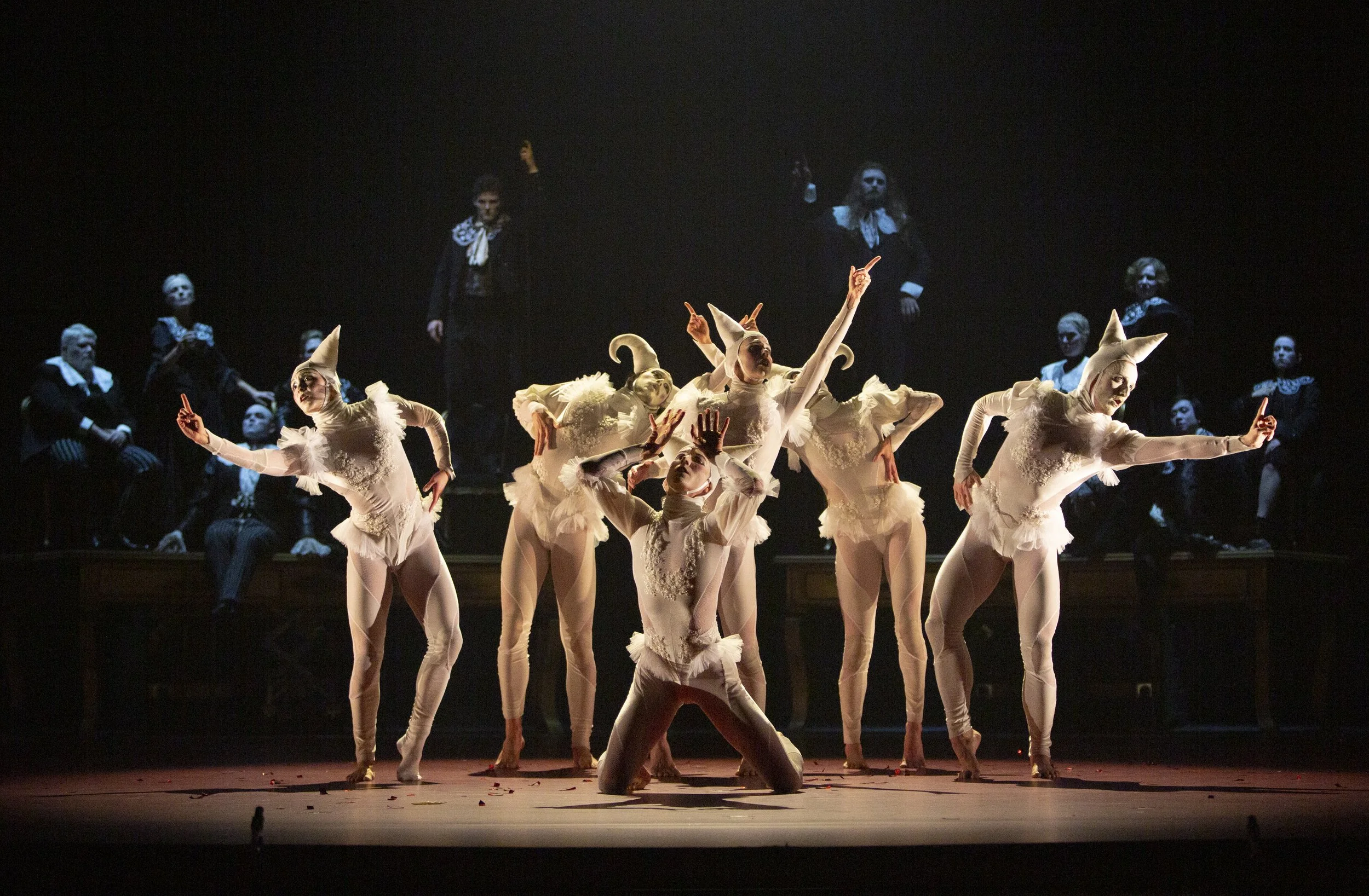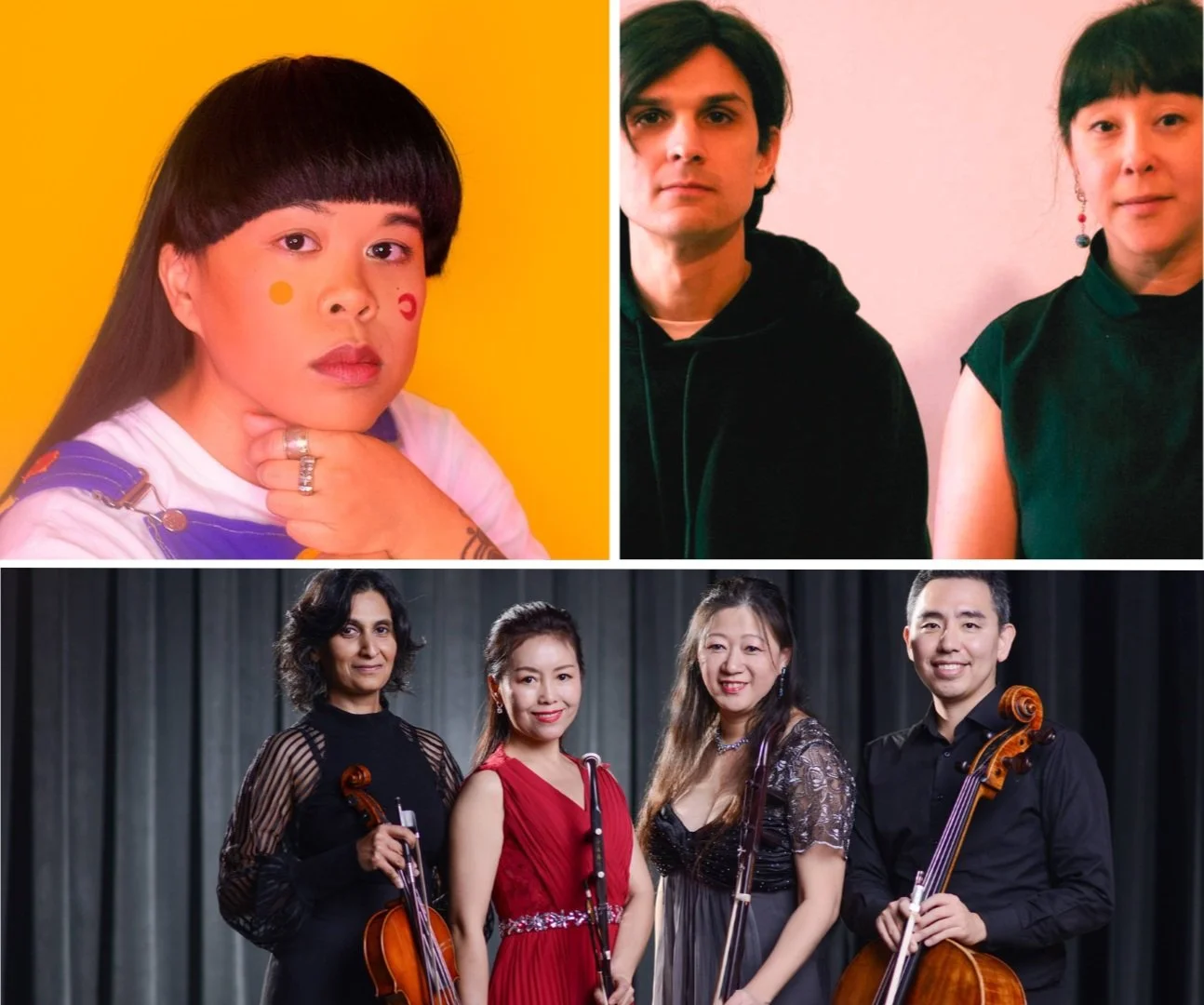Review: Vancouver Opera's Orfeo ed Euridice conjures a dreamlike world of serene dancing and music
Balloons, chandeliers, and ghost-white jesters make for a fascinating, Felliniesque interpretation
The surreal dancers in Orfeo and Euridce are a highlight, as is the chorus positioned behind them. Photo by Tim Matheson
Vancouver Opera, The Dance Centre, and Ne.Sans Opera and Dance presented Orfeo ed Euridice at the Queen Elizabeth Theatre on December 4 and 5. No remaining performances.
VANCOUVER OPERA’s new rendition of Orfeo ed Euridice begins with a literal bang: scarlet-gowned, raven-haired Amore (Mireille Asselin) pops a white balloon that releases a flurry of red-foil confetti.
It’s an apt introduction to a playful show that conjures magic out of a striking palette of black, white, and red. Director Idan Cohen reimagines Christoph Willibald Gluck’s 1762 Baroque opera as a stylized, Felliniesque dream, populated by ghost-white clown-ballerinas dressed in mock tutus and pointy jester hats, and a chorus that includes, by turns, bewigged judges, Edwardian partygoers, and Venetian masqueraders.
It’s set amid a red circus-like ring, with three gigantic gold-glittering chandeliers and heavy black curtains. Amir Ofek’s design is gorgeous yet simple, the effect heightened by Itai Erdal’s lighting.
The singing and dancing are equally exquisite. The opera, based on an ancient Greek myth, begins with Mireille Lebel’s Orfeo mourning the death of his wife Euridice (Krisztina Szabó). In one of the production’s several show-stopping moments, her shrouded body rises eerily to the heavens as the chorus sings its serene lament. Orfeo heads to Hades to bring her back to the world of the living. But goddess Amore’s only stipulation is that he mustn’t look at Euridice—much to his wife’s distress.
Lebel beautifully maneuvers Orfeo’s demanding range, bringing a luminosity to the high register and resonance to the low; she really hits her stride in Gluck’s most famous aria, “Che farò senza Euridice” (“What will I do without Euridice?”). Szabó pours out passion, imbuing the ornamentation with an emotional richness that takes it beyond the decorative.
Mireille Lebel and Krisztina Szabo struggle with life and death in Orfeo ed Euridice. Photo by Tim Matheson
The members of the 20-strong chorus make the most of their first return to the stage since pandemic shutdown. In Act 2, they sit on chairs raised up on tables to consider Orfeo’s plight and then let fly at him. Maestro Leslie Dala takes the necessary light touch with the orchestra that’s augmented with a harpsichord, never rushing the tempo; the well-known Dance of the Blessed Spirits is a transcendent highlight.
The extraordinary dancers—Aiden Cass, Alexis Fletcher, Kate Franklin, Ted Littlemore, Rachel Meyer, and Hana Rutka—are mesmerizing. In this dance-iest of all Vancouver Operas, they’re fully integrated into the production, reflecting and interpreting the themes in the story. At times they move like music-box ballerinas, at others, they arch backward and slide along the floor like creatures from the underworld.
In Cohen’s contemporary take, the dancers help build on the idea that love and life are all part of some grand, dark cabaret. (Note the iconic scalloped curtains that frame a lot of the action and the way Cohen slyly references the mannered gestures of Baroque opera.) In this Orfeo, the role of the artist in society is always being questioned and acknowledged in clever ways.
Evan Clayton’s costumes are invaluable to creating this world, whether it’s the dancers’ Renaissance-surreal conical hats and deconstructed tutus or Euridice’s rippling white gown with its blood-red edges. The apparel plays savvily with the production’s black, white, and red palette and blurs the eras into a look that’s a brilliant mashup of Picasso’s Jester; Black Swan; I, Clown; and (this one according to Clayton) Vampire Hunter anime.
What’s most exciting about this cool, contemporary production—which could stand strong on any operatic stage in the world—is that it was created entirely by a passionate group of homegrown talent. Vancouver-based Ne.Sans Opera and Dance director Cohen is an alumnus of Israel’s lauded Kibbutz Contemporary Dance Company who’s trained in classical piano and theatre. He has been developing this opera for four years, collaborating with a strong, impressive, and diverse team of local innovators.
So the real magic here might be that a team of imaginative artists has been able to create something this dazzling out of the pandemic void. And that’s as remarkable as the finale’s symphony of tinsel-exploding balloons.














